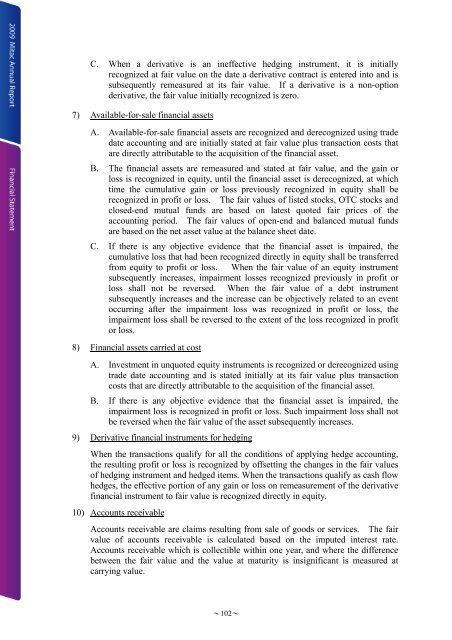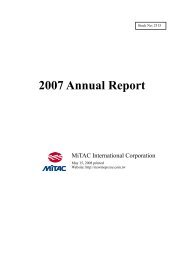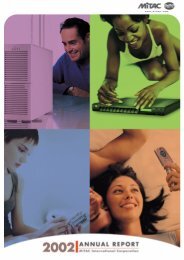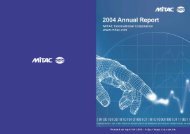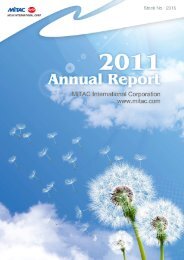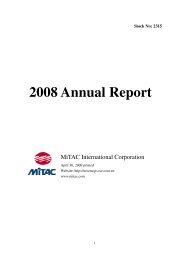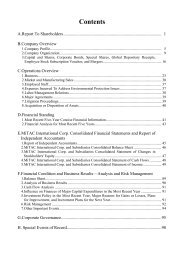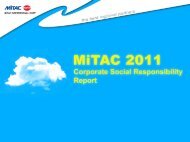Letter To Shareholders - Mitac
Letter To Shareholders - Mitac
Letter To Shareholders - Mitac
You also want an ePaper? Increase the reach of your titles
YUMPU automatically turns print PDFs into web optimized ePapers that Google loves.
C. When a derivative is an ineffective hedging instrument, it is initially<br />
recognized at fair value on the date a derivative contract is entered into and is<br />
subsequently remeasured at its fair value. If a derivative is a non-option<br />
derivative, the fair value initially recognized is zero.<br />
7) Available-for-sale financial assets<br />
A. Available-for-sale financial assets are recognized and derecognized using trade<br />
date accounting and are initially stated at fair value plus transaction costs that<br />
are directly attributable to the acquisition of the financial asset.<br />
B. The financial assets are remeasured and stated at fair value, and the gain or<br />
loss is recognized in equity, until the financial asset is derecognized, at which<br />
time the cumulative gain or loss previously recognized in equity shall be<br />
recognized in profit or loss. The fair values of listed stocks, OTC stocks and<br />
closed-end mutual funds are based on latest quoted fair prices of the<br />
accounting period. The fair values of open-end and balanced mutual funds<br />
are based on the net asset value at the balance sheet date.<br />
C. If there is any objective evidence that the financial asset is impaired, the<br />
cumulative loss that had been recognized directly in equity shall be transferred<br />
from equity to profit or loss. When the fair value of an equity instrument<br />
subsequently increases, impairment losses recognized previously in profit or<br />
loss shall not be reversed. When the fair value of a debt instrument<br />
subsequently increases and the increase can be objectively related to an event<br />
occurring after the impairment loss was recognized in profit or loss, the<br />
impairment loss shall be reversed to the extent of the loss recognized in profit<br />
or loss.<br />
8) Financial assets carried at cost<br />
A. Investment in unquoted equity instruments is recognized or derecognized using<br />
trade date accounting and is stated initially at its fair value plus transaction<br />
costs that are directly attributable to the acquisition of the financial asset.<br />
B. If there is any objective evidence that the financial asset is impaired, the<br />
impairment loss is recognized in profit or loss. Such impairment loss shall not<br />
be reversed when the fair value of the asset subsequently increases.<br />
9) Derivative financial instruments for hedging<br />
When the transactions qualify for all the conditions of applying hedge accounting,<br />
the resulting profit or loss is recognized by offsetting the changes in the fair values<br />
of hedging instrument and hedged items. When the transactions qualify as cash flow<br />
hedges, the effective portion of any gain or loss on remeasurement of the derivative<br />
financial instrument to fair value is recognized directly in equity.<br />
10) Accounts receivable<br />
Accounts receivable are claims resulting from sale of goods or services. The fair<br />
value of accounts receivable is calculated based on the imputed interest rate.<br />
Accounts receivable which is collectible within one year, and where the difference<br />
between the fair value and the value at maturity is insignificant is measured at<br />
carrying value.<br />
~102~


